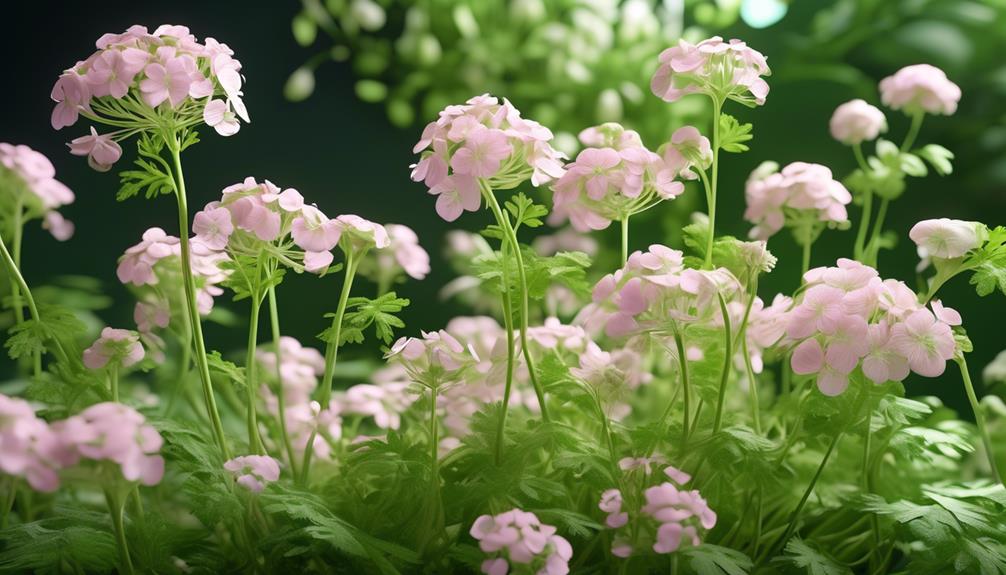As you stroll through the bustling farmers market, a vibrant burst of color catches your eye. Amongst the familiar herbs and spices, you notice a delicate cluster of coriander blossoms. Intrigued, you wonder what secrets these hidden flowers hold. What makes them so special?
And how can they elevate your culinary adventures to new heights? Join us as we unveil the captivating world of coriander blossoms, exploring their unique flavors, cultural significance, and the art of incorporating them into your dishes.
Prepare to embark on a journey of aromatic delight, where every petal reveals a story waiting to be discovered.
Cilantro Flower Appearance
Cilantro flowers are delicate clusters that come in small, lacy formations, displaying hues of white, lavender, or deep purple, with slender green stems and feathery leaves. These coriander blossoms are the hidden flower of aromatic delight. Their appearance is truly captivating, adding a touch of elegance to any dish.
The flowers are dainty and intricate, with their delicate petals creating a beautiful display. The slender green stems provide a graceful contrast to the vibrant colors of the flowers. And the feathery leaves give a soft and airy texture to the overall appearance.
When garnishing your dishes with cilantro flowers, their exquisite appearance will surely impress your guests and elevate the visual appeal of your culinary creations.
Story and Origins
As we explore the story and origins of coriander blossoms, we uncover the rich history and cultural significance behind this aromatic delight. Coriander, an ancient herbaceous plant, is believed to be native to Southern Europe and Asia Minor. It has a history dating back to at least 2500 BCE in Egypt and ancient Greece and Rome. The flowers, also known as cilantro, Chinese parsley, or Mexican parsley, have a sweet and pungent aroma, adding a bright and grassy flavor to various cuisines around the world. These hidden flowers are not only a source of vitamins and antioxidants but also a symbol of diverse culinary traditions. Let's take a closer look at the table below to appreciate the cultural significance and global reach of coriander blossoms:
| Cuisine | Cultural Significance | Aromatic Delight |
|---|---|---|
| Indian | Essential in curries and chutneys | Adds a fresh and citrusy note to dishes |
| Mexican | Used in salsas and guacamole | Provides a vibrant and herbal undertone |
| Middle Eastern | A key ingredient in falafel and hummus | Enhances the earthy and nutty flavors |
| Asian | Found in stir-fries and noodle dishes | Imparts a fragrant and aromatic essence |
| Greek | Present in tzatziki and Greek salads | Contributes a cool and refreshing taste |
These examples demonstrate how coriander blossoms have woven their way into the tapestry of global cuisine, enriching dishes with their unique flavors and scents. The story and origins of these hidden flowers continue to inspire and delight food lovers worldwide.
Cultural Significance
The cultural significance of coriander blossoms lies in their ability to enhance the flavors and aromas of diverse cuisines around the world. These hidden flowers are an aromatic delight that adds a unique touch to various culinary traditions.
From Indian curries to Mexican salsas, coriander blossoms bring a burst of freshness and complexity to dishes, elevating them to new heights of flavor. Their cultural significance is evident in the widespread use of coriander blossoms in different cuisines, showcasing their versatility and importance in global culinary traditions.
Whether it's the vibrant colors of Indian cuisine or the bold flavors of Latin American dishes, coriander blossoms play a crucial role in creating unforgettable culinary experiences. Their presence on the plate not only enhances the taste but also represents the rich cultural tapestry of the communities that incorporate them into their cooking.
Cultural and Historical Meanings
Throughout history, coriander has held a significant cultural role as a versatile ingredient used in diverse cuisines around the world. Its cultural and historical meanings are deeply rooted in ancient civilizations like Egypt, Greece, and Rome, where coriander was utilized for culinary and medicinal purposes.
This hidden flower, known for its aromatic delight, is a key ingredient in the cuisines of many different cultures, including Indian, Latin American, Middle Eastern, and Asian cuisines. Its historical significance is evident in the migration and cultivation of coriander seeds by Spanish colonists in North and South America, contributing to its popularity in Latin American cuisine.
Moreover, the cultural and genetic influences on the perception of food and flavors are highlighted by the genetic variation in cilantro perception, where approximately 10% of the population perceives its flavor as soapy or unpleasant. The adaptability of individuals and cultures to different flavors and ingredients is also emphasized by the fact that exposure to coriander can build up a tolerance to the compounds that initially cause dislike.
Caring for Cilantro Flowers
To care for cilantro flowers, you need to ensure proper sunlight and soil. Plant cilantro in a spot with full sun or partial shade and well-draining soil for optimal growth.
Adequate watering is also essential. Water cilantro regularly, especially during germination, adjusting frequency based on climate and soil type to maintain consistent moisture.
To prevent cilantro from bolting early, weed regularly, provide balanced watering, and protect from extreme weather conditions.
Harvest cilantro flowers when they're fresh and ready, ensuring to use them fresh in culinary applications and never dried.
If you're growing cilantro in a container, tailor the soil composition, provide optimal sunlight, and protect the container from extreme weather conditions for successful growth.
Follow these care guidelines to enjoy the hidden flower of aromatic delight, the coriander blossoms.
Gift-Giving Occasions for Cilantro Flowers
For those seeking unique and thoughtful gifts, cilantro flowers offer a delightful surprise for any occasion. Whether it's a spring wedding, a summer barbecue, a fancy dinner party, or an anniversary celebration, these hidden flowers can add a touch of aromatic delight to the festivities.
With their delicate white petals and intense coriander flavor, cilantro flowers not only enhance the presentation and taste of dishes but also make a distinctive and memorable gift for food enthusiasts or anyone who appreciates culinary delights.
The fact that cilantro flowers are available year-round makes them an accessible option for gift-giving occasions, providing a consistent surprise for birthdays, anniversaries, or even just a spontaneous gesture of appreciation.
Concluding Thought
Consider incorporating cilantro flowers into your culinary repertoire for a unique and aromatic twist that will impress your taste buds and elevate your dishes to new heights. The hidden flower of coriander blossoms is truly an aromatic delight that adds a burst of flavor and visual appeal to your meals. Whether you sprinkle them over salads, use them as a garnish, or infuse them into oils and sauces, cilantro flowers bring a touch of elegance and sophistication to any dish. Their delicate petals and vibrant green color create a stunning contrast against the backdrop of your culinary creations. So why not embrace the versatility of cilantro flowers and explore the endless possibilities they offer? Share your experiences and recipes with the food enthusiast community, and together, let's celebrate the wonders of this hidden flower.
| Hidden Flower | Aromatic Delight | Culinary Versatility |
|---|---|---|
| Burst of flavor | Elegant touch | Stunning contrast |
| Visual appeal | Sophistication | Endless possibilities |
| Delicate petals | Culinary creations | Community celebration |
Frequently Asked Questions
What Is the Meaning of the Coriander Flower?
The meaning of the coriander flower is often associated with its aromatic qualities and culinary uses. It adds a delightful burst of flavor and fragrance to various dishes, making it a hidden gem in the world of edible flowers.
Can You Eat the Flowers of Coriander?
Yes, you can eat the flowers of coriander. They have a sweet and pungent aroma, a bright and grassy flavor with citrusy hints, and a peppery finish. They make a great garnish or finishing touch in various cuisines.
What Is the Difference Between Cilantro and Coriander?
The difference between cilantro and coriander lies in their form and usage. Cilantro refers to the fresh leaves, while coriander refers to the dried seeds. Cilantro has a citrusy flavor, while coriander has a warm and nutty taste.
What Is the Coriander Used For?
Coriander is used to add a burst of flavor and visual appeal to your dishes. Sprinkle its petals on soups, curries, and stir-fries or blend them into sauces and dips. It's a versatile herb that enhances your culinary creations.





